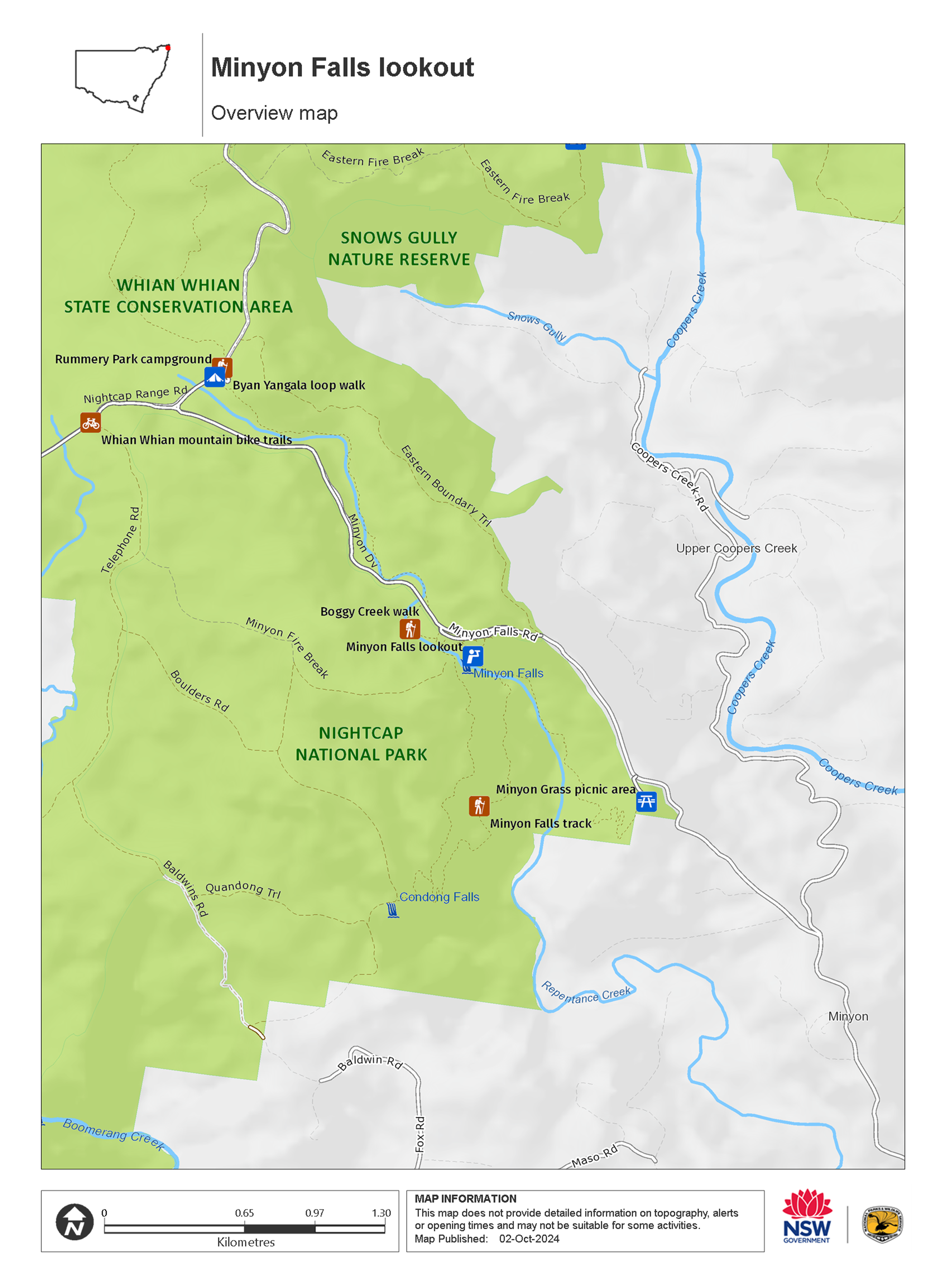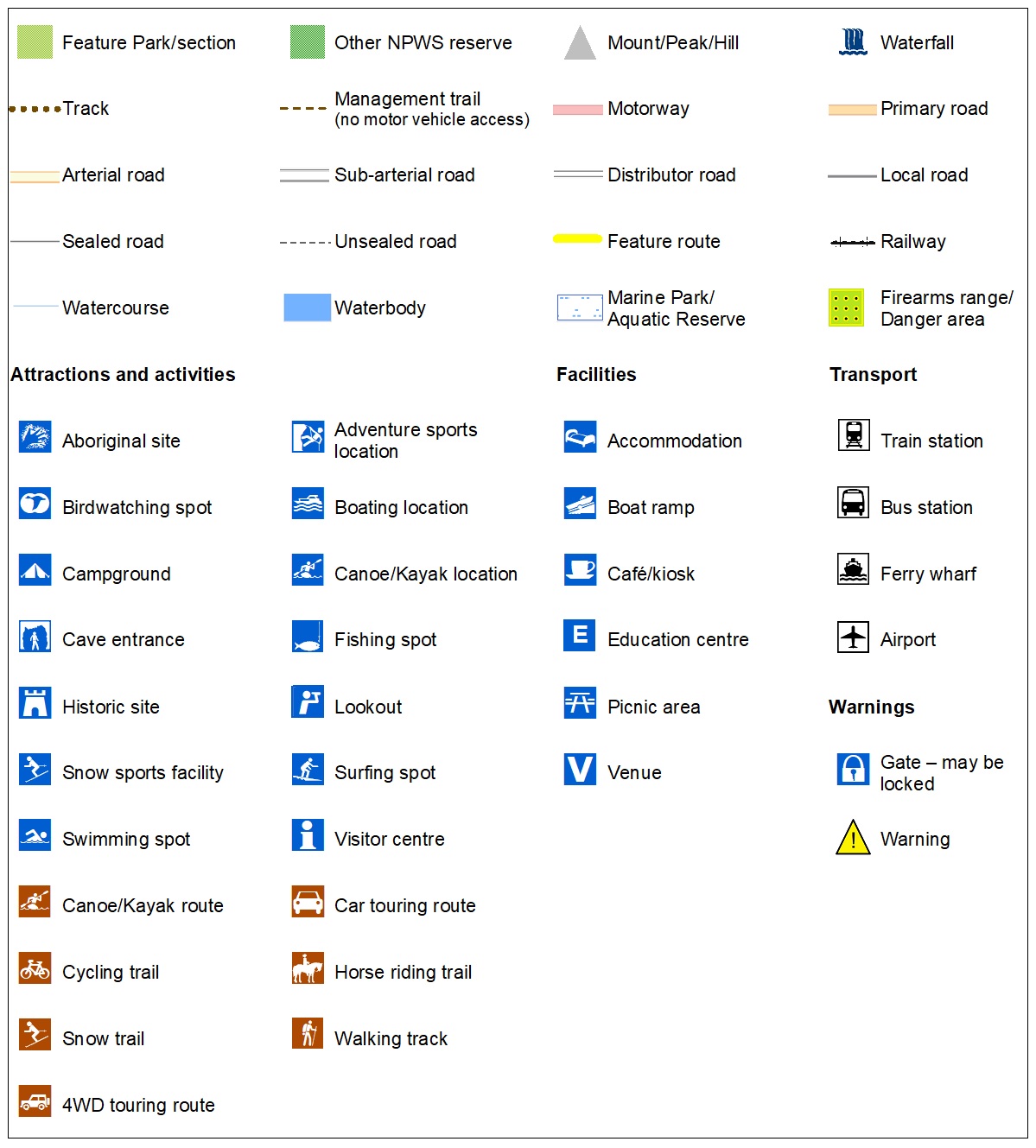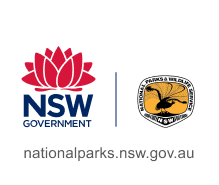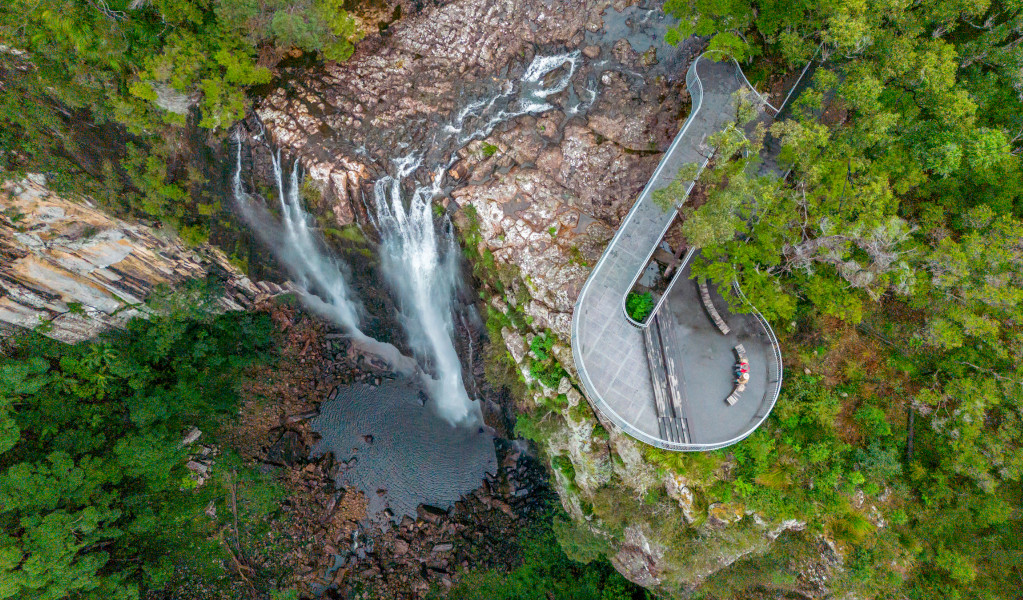Minyon Falls lookout
Nightcap National Park
Overview
Minyon Falls lookout offers stunning views of the waterfall and rainforest. With easy parking and picnic spots, it's a great day trip location for people visiting Byron Bay.
- Type
- Lookouts
- Where
- Nightcap National Park in North Coast
- Accessibility
- Easy
- What to
bring - Drinking water
- Please note
- Please note there is no public access within 100m of the top of Minyon Falls.
- Check the weather before you visit Minyon Falls, as the falls might not be flowing strongly if you are visiting during a dry spell. They will be at its most impressive after wet weather.
The view from Minyon Falls lookout is the best in the area. From the lookout platform you can admire not only the falls themselves and the valley beneath, on a clear day you might be lucky and see all the way out to the coast.
Watch the cascades flow over Minyon Falls to a deep palm-shaded gorge roughly 100m below, and enjoy the sounds of local wildlife, the peaceful ambience and the spectacular natural surroundings. The tops of the cliffs are forested with Australian eucalypts, like blackbutt and scribbly gum, and a beautiful pool at the base of the falls is an ideal place to cool off and relax.
Minyon Falls is great for a quick stop, but if you’d like to spend longer at this majestic location there's a picnic area with plenty of shady trees and picnic tables. There are also a couple of bushwalks that leave from the picnic area, including Boggy Creek walk which leads to Rummery Park campground, and Minyon Falls walking track which takes you down to the base of the falls.
And while Minyon Falls does offer stunning vistas and beautiful scenery, it's more than just a spot of visual grandeur. It's also a special place for the local Aboriginal community.
Nearby:
-

Minyon Falls walking track
Popular with visitors to the Byron Bay area, Minyon Falls walking track leads through rainforest to a scenic waterfall in Nightcap National Park, in northern NSW.
-

Boggy Creek walk
Boggy Creek walk in Whian Whian State Conservation Area takes you through blackbutt forest and along the beautiful Boggy Creek to Minyon Falls. You can swim in the inviting pools along the creek.
-

Whian Whian mountain biking trails
Suitable for bushwalkers, cyclists and horseriders, Whian Whian mountain biking trails near Byron Bay offer stunning views of waterfalls and rainforest.
-

Minyon Grass picnic area
Minyon Grass picnic area, at the base of Minyon Falls in Nightcap National Park, near Lismore, is a beautiful place for lunch, offering a range of rainforest walks.
Map

Map legend

Local alerts
For the latest updates on fires, closures and other alerts in this area, see https://www.nationalparks.nsw.gov.au/things-to-do/lookouts/minyon-falls-lookout/local-alerts
General enquiries
- National Parks Contact Centre
- 7am to 7pm daily
- 1300 072 757 (13000 PARKS) for the cost of a local call within Australia excluding mobiles
- parks.info@environment.nsw.gov.au
Park info
- in Nightcap National Park in the North Coast region
Nightcap National Park is always open but may have to close at times due to poor weather, fire danger or management operations.
Visitor info
All the practical information you need to know about Minyon Falls lookout.
Maps and downloads
Learn more
Minyon Falls lookout is in Nightcap National Park. Here are just some of the reasons why this park is special:
Aboriginal heritage

Nightcap National Park is the traditional land of the Bundjalung People, in particular the Widjabul People who have inhabited the area for thousands of years. The park contains many ancient sites of cultural significance, including ceremonial and sacred sites that are still used by local Aboriginal people today. The creeks, plants, animals and landscape of the park feature in the stories, teachings and practices of Aboriginal people that continue to be passed on today.
Ancient rainforest

Nightcap National Park's rainforests are part of the Gondwana Rainforests of Australia World Heritage Area, the largest area of subtropical rainforest in the world. They are a living link to the environment of ancient Australia and give us insight into the environment of the ancient supercontinent of Gondwana.
This lush and diverse conservation area protects a number of vulnerable and threatened species such as the rufous scrub bird, red goshawk, sooty and masked owls and regent bowerbirds. It is also home to the recently discovered nightcap oak, which can grow up to 40m high.
Ground-breaking protests at Terania Creek in the late 1970's paved the way for the park's creation and international recognition as a Gondwana Rainforest World Heritage site in 1986.
- Minyon Falls guided rainforest tour Journey through ancient rainforest to Minyon Falls on a 5-hour tour with Wild Byron. You’ll see the stunning creeks, waterfalls and wildlife of Nightcap National Park.
- Protesters Falls walking track Protestors Falls walking track is nestled within the rugged ranges of Nightcap National Park, near Lismore. The track leads through magnificent World Heritage-listed rainforest to a stunning waterfall.
- Terania Creek picnic area Terania Creek picnic area in Nightcap National Park is a hidden gem and well worth a visit. With good facilities, a gorgeous creek and access to walking tracks and waterfalls, it’s perfect for a family picnic.
Frogs galore

The rainforest creeks in Nightcap National Park are home to a number of threatened frogs, including Fleay's barred frog and the pouched frog. You might see Fleay's barred frogs hiding under leaf litter near streams or foraging for food on the rainforest floor, but you're more likely to hear their chorus, a distinctive 'arrrrrrk'. This rare frog feeds mainly on insects and invertebrates, so crickets, moths and beetles make a good meal. Keep your eyes open for this pale brown frog around Terania creek at the base of Protesters Falls.
- Byron glow worms and hinterland forest experience Discover Byron Bay’s hidden side and see glow worms and enchanting forest sights on this guided outing with Rise Up – Byron Conscious Tours. You'll delight your senses and relax your mind as you explore the wilderness in and around Nightcap National Park.
- Goorgana walking track Goorgana walking track is ideal for experienced bushwalkers keen to tackle the challenging iconic peaks in Nightcap National Park.
- Minyon Falls guided rainforest tour Journey through ancient rainforest to Minyon Falls on a 5-hour tour with Wild Byron. You’ll see the stunning creeks, waterfalls and wildlife of Nightcap National Park.
- Night vision rainforest walks in Byron Bay Discover elusive native animals at night as you strap on a pair of special goggles and venture out for a thrilling rainforest tour beneath the stars with the friendly guides of Vision Walks Eco Tours.
- Terania Creek picnic area Terania Creek picnic area in Nightcap National Park is a hidden gem and well worth a visit. With good facilities, a gorgeous creek and access to walking tracks and waterfalls, it’s perfect for a family picnic.
History buffs

Nightcap National Park contains a number of sites of historical interest, including a flying fox on the Googarna track. The flying fox was used to lower logs 500m down to the Kunghur mill during the 1940s and 1950s. The historic Nightcap track provided the first bridle track and telegraph line between the Richmond and Tweed valleys in the 1870s, and today you can explore this track on foot, camping overnight in the bush.
Plants and animals protected in this park
Animals
-

Albert's lyrebird (Menura alberti)
The Albert’s lyrebird is much rarer than the superb lyrebird. Distinguished by its richer brown plumage and less elaborate tail feathers, it’s protected as a threatened species in NSW.
-

Satin bowerbird (Ptilonorhynchus violaceus)
With vibrant blue-violet eyes and curious antics, the satin bowerbird is a favourite for bird watching and easy to spot as it forages for food in open forest. Relatively common across eastern Australia, in NSW they’re found in coastal rainforests and adjacent woodlands and mountain ranges.
-

Australian brush turkey (Alectura lathami)
The Australian brush turkey, also known as bush or scrub turkey, can be found in rainforests along eastern NSW. With a striking red head, blue-black plumage and booming call, these distinctive Australian birds are easy to spot while bird watching in several NSW national parks.
-

Lace monitor (Varanus varius)
One of Australia’s largest lizards, the carnivorous tree-dwelling lace monitor, or tree goanna, can grow to 2m in length and is found in forests and coastal tablelands across eastern Australia. These Australian animals are typically dark blue in colour with whitish spots or blotches.
-

Grey-headed flying-fox (Pteropus poliocephalus)
The grey-headed flying fox is Australia's largest native bat, with a wingspan up to 1m. This threatened species travels up and down south-eastern Australia and plays a vital role in pollinating plants and spreading seeds in our native forests.
Plants
-

Coachwood (Ceratopetalum apetalum)
Coachwood trees are Australian native plants that grow in warm temperate rainforests along coastal NSW. Also known as scented satinwood, the mottled grey bark of the coachwood has horizontal markings and a delicate fragrance.
-

Blueberry ash (Elaeocarpus reticulatus)
The blueberry ash is a rainforest shrub which produces blue olive-shaped berries and spectacular bell-shaped flowers, which often appear on the plant together. It is a tall slender shrub or small tree found in rainforest, tall eucalypt forest and coastal bushland in eastern NSW, south-east Queensland and Victoria.

